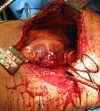Thoracic compartment syndrome after penetrating heart and lung injury
- PMID: 31275797
- PMCID: PMC6545437
- DOI: 10.3205/iprs000133
Thoracic compartment syndrome after penetrating heart and lung injury
Abstract
Thoracic injuries are the most lethal penetrating injuries. After attempting suicide, two patients with a penetrating thoracic wound were admitted to our emergency department. During CT scan they became hemodynamically unstable, which is why we had to perform an emergency thoracotomy. In both cases, a perforation in the left ventricle as well as multiple lesions of the lung parenchyma and vessel injuries were found. After the treatment of the different injuries, a massive edema of the heart and lung prevented a primary closure of the thorax. Due to massive diffuse bleeding, a "packing" of the pleural cavity became necessary. To prevent a thoracic compartment syndrome, the thoracic wall was left open and the skin was closed with a plastic sheet. Due to the "open chest" procedure combined with "packing" of the thoracic cavity, the majority of patients with an edema of the heart and lung after a penetrating chest injury can be saved. Pitfalls of preclinical and clinical treatment, aspects of diagnostics and surgery are discussed.
Thorakale Verletzungen sind die tödlichsten penetrierenden Verletzungen.Zwei Patienten wurden nach einem Suizidversuch mit einer penetrierenden Thoraxverletzung in unsere Notaufnahme eingeliefert. Während der CT-Untersuchung kam es zu einer Kreislaufdekompensation, so dass die notfallmäßige Thorakotomie erfolgen musste. In beiden Fällen fand sich eine Perforation im linken Ventrikel neben multiplen Lungenparenchym- und Gefäßverletzungen. Nach Versorgung der verschiedenen Läsionen verhinderte ein massives Ödem des Herzens und der Lunge einen Primärverschluss des Thorax, wobei wegen diffuser Blutung noch ein „Packing“ der Thoraxhöhle notwendig wurde. Zur Prävention eines Kompartmentsyndroms blieb der knöcherne Thorax offen und es wurde nur die Haut mit einer Plastikfolie verschlossen. Aufgrund der Kombination des offen belassenen Thorax und des Austamponierens der Thoraxhöhle kann die Mehrzahl der Patienten mit einem Herz-Lungen-Ödem nach penetrierender Verletzung gerettet werden.Fallstricke der präklinischen und klinischen Behandlung sowie Aspekte der Diagnostik und Operation werden diskutiert.
Keywords: bogota bag; compartment syndrome; myocardial and lung edema; packing; penetrating heart and lung injury.
Conflict of interest statement
The authors declare that they have no competing interests.
Figures









Similar articles
-
Emergency operation for penetrating thoracic trauma in a metropolitan surgical service in South Africa.J Thorac Cardiovasc Surg. 2011 Sep;142(3):563-8. doi: 10.1016/j.jtcvs.2011.03.034. J Thorac Cardiovasc Surg. 2011. PMID: 21843762
-
[Indications for emergency surgery in thoraco-abdominal injuries].Acta Chir Orthop Traumatol Cech. 2001;68(6):374-9. Acta Chir Orthop Traumatol Cech. 2001. PMID: 11847930 Czech.
-
Predictors of survival after emergency department thoracotomy in trauma patients with predominant thoracic injuries in Southern Israel: a retrospective survey.Open Access Emerg Med. 2019 Apr 23;11:95-101. doi: 10.2147/OAEM.S192358. eCollection 2019. Open Access Emerg Med. 2019. PMID: 31114402 Free PMC article.
-
Damage control surgery in lung trauma.Colomb Med (Cali). 2021 May 10;52(2):e4044683. doi: 10.25100/cm.v52i2.4683. Colomb Med (Cali). 2021. PMID: 34188322 Free PMC article. Review.
-
Use of a Modified ABTHERA ADVANCE™ Open Abdomen Dressing with Intrathoracic Negative-Pressure Therapy for Temporary Chest Closure After Damage Control Thoracotomy.Am J Case Rep. 2022 Sep 25;23:e937207. doi: 10.12659/AJCR.937207. Am J Case Rep. 2022. PMID: 36153642 Free PMC article. Review.
References
-
- Salehian O, Teoh K, Mulji A. Blunt and penetrating cardiac trauma: a review. Can J Cardiol. 2003 Aug;19(9):1054–1059. - PubMed
Publication types
LinkOut - more resources
Full Text Sources

